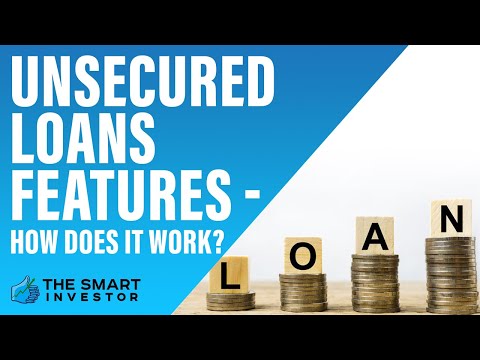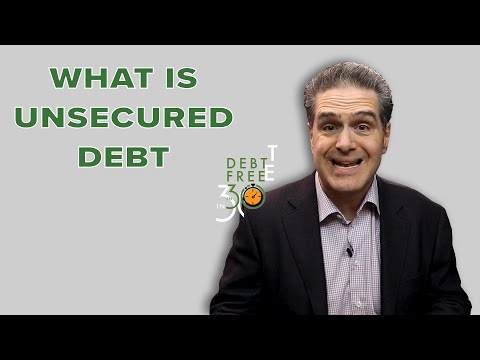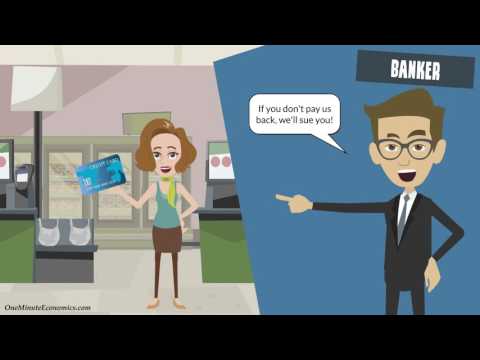In the world of finance, unsecured debt often feels like a dance on a tightrope—thrilling for some, nerve-wracking for others. It’s the financial high-wire act that doesn’t involve your assets as a safety net, which makes the term ‘unsecured’ a bit of a misnomer. In reality, unsecured debt is not protected or free from the danger or risk of loss; it’s quite the contrary. Let’s dive into the world of unsecured loans and uncover some mind-blowing facts that might just have you rethinking your balance sheet.

Unsecured Loans Unveiled: What is Unsecured Debt?

Unveiling the Unsecured Loan Definition: More Than Just a Signature
It’s critical to grasp the unsecured loan definition; essentially, what is unsecured debt? Unsecured debt refers to loans not backed by collateral. So, if you take a stroll down Unsecured Lane, you’ll find credit cards and personal loans waving to you. These debts are based on your creditworthiness, without requiring your car, house, or family heirlooms as leverage. The clear contrast between secured and unsecured loans is stark: with secured loans, think of the bank having a spare set of keys to your stuff. With unsecured? It’s just your signature—and your good name—on the line.

How Unsecured Debt Shapes the Economy: A Look at Credit Scores
Unsecured debt, with its easy-breezy entry, has a love-hate relationship with credit scores. It’s simple: maintain a ballet of balance and timely payments, and your score pirouettes higher. Slip up, and it’s a credit score nosedive. With the average American juggling $6,194 in credit card debt, it’s a juggling act that can make or break consumer spending power. Lenders peer into your financial crystal ball—your credit score—to predict if you’ll be their monetary friend or foe in the unsecured lending arena.
Unsecured vs. Secured Debt: The Interest Rate Divide
Navigating the divide between unsecured and secured debt is like comparing stormy seas to a calm harbor. Unsecured loans bravely wave their flags with higher interest rates—thank you, additional risk—while secured loans, cozy with collateral, boast lower rates. Visa and MasterCard, for instance, may charge a robust APR hovering around 16% to 24% for unsecured credit card debt, whereas home equity lines of credit—a species of secured debt—flaunt rates that can be less than half that.
The Big Players in Unsecured Lending: Who Dominates the Market?
It’s a market molded by the likes of American Express and Discover, who steer the ship of unsecured lending with confidence. With their fingers on the pulse of consumer desire for swift and collateral-free cash, these giants have fine-tuned their lending practices to entice spenders—while keeping an eagle eye on risk. Their decisions ripple through the economy, influencing not just lending practices at large, but the financial wellbeing of Main Street.
The Startling Truth About Unsecured Debt in Times of Crisis
Remember when ‘unprecedented’ became the word du jour during the COVID-19 pandemic? Well, unsecured debt had its moment in that limelight too. While some tightened their belts, others racked up debt like there was no tomorrow. When crisis hits, unsecured debt can either be a life preserver or an anchor—and its impact on financial system resilience is profound, with ripples felt in every nook of the economy.
Unsecured Debt and Innovation: Fintech’s Role in Shaping the Future
The fintech revolution, with players like SoFi and Affirm, is reshaping the landscape of unsecured lending with the force of a technological tornado. They’ve turned unsecured loans on their head, offering everything from microloans to buy-now-pay-later schemes, sometimes at the tap of a smartphone. This daring dash of innovation makes borrowing as easy as ordering a pair of hoka hiking Boots, but with it comes the question: are we smoothing the path to financial stability, or greasing the slope to debt dependency?
What Happens When Unsecured Debt Goes Unpaid: The Collection Process
Now, here’s where things get a bit dicey. When unsecured debt goes unpaid, cue the twin sirens of stress and collection calls. Collectors embark on a persistent chase, akin to an Rbd tour, where there’s no autograph signing, just asset hunting—though, with unsecured debt, they may have their work cut out for them. Legal maneuvers become the moves du jour, and with the recent updates to bankruptcy law, navigating the course can feel more intricate than grooving to John Fogerty’s hits.

Conclusion: The Paradox of Unsecured Debt
The world of unsecured debt is undeniably a para-dox of modern finance—a blend of risk and reward, freedom and potential fallout. As we’ve journeyed through the complex landscape, it becomes apparent that unsecured debt carries a significant, and sometimes hidden, weight in both personal finances and the broader economy.
Yet the allure remains—finding a mortgage or borrowing cash without putting your assets in the crosshairs, the expedience of Swab login transfers, or the promotion of borrowing freedom are potent. But let’s not forget, for all its ease, the repercussions of unsecured debt can be long-lasting.
Whether you’re an individual reading the fine print of a credit card agreement or a lender weighing the risk of an unsecured portfolio, remember to tread carefully. The tension between accessibility and risk is a delicate balance, and with the pace of financial innovation showing no signs of slowing, keeping a close eye on trends is key.

For those considering their options, recall the adage: ‘Measure twice, cut once.’ And when it comes to unsecured debt, that’s sage advice. Whether you’re leveraging Secured Vs unsecured loan options or contemplating your next financial step, a calculated, informed approach is paramount. Because ultimately, in the world of unsecured debt, while you may not be signing away your assets, you are indeed betting on your financial future.
The Wild World of Unsecured Debt
Hey there, debt aficionados and finance whizzes! Buckle up because we’re about to dive headfirst into a treasure trove of quirky tidbits about unsecured debt that’ll knock your socks off. I mean, who would’ve thought that money matters could be as entertaining as jamming out to some john Fogerty Hits?
The Roller Coaster of Credit Score Thrills
You know that feeling of excitement you get when driving a sleek Honda cr z? Well, your credit score feels that kind of thrill every time it takes a turn thanks to unsecured debt. Because this type of debt isn’t backed by collateral, lending institutions are like nervous parents at a high school dance, closely watching those credit scores shimmy and shake to determine if they’re going to cut in with a loan approval.
Unbelieve-a-Loan Differences
Ever compared a wild ride on a roller coaster to the thrill of securing a loan? Probably not, unless you’re into that sort of thing. But here’s the kicker: there’s a world of a difference between unsecured loans and their loan Secured siblings. While secured loans are like having a safety net (because they’re backed by your assets), unsecured loans are like tightrope walking without a net—exciting, sure, but oh boy, is it risky!
Internet’s Hidden Treasure Troves
Ah, the internet, where the quest for financial know-how is as relentless as searching for that legendary pot of gold. Lucky for you, seeking assistance for your unsecured debt quandaries can be as simple as making a Scwab Login. Don’t let the name confuse you; it’s not your average gardening tool. It’s like a secret handshake that grants you entry to a world of savvy financial advice and resources. You’re now part of the club, my friend.
The Beat Goes On… and on Debt!
Hit it! Just like the bangers in “john fogerty hits”, the rhythm of unsecured debt is relentless. It doesn’t take a break, and before you know it, you’re caught in the encore of an ever-growing debt concert. But fear not, for with the right financial moves, you can turn that endless encore into the final bow, waving goodbye to unsecured debt like a rockstar at the end of an epic show.
With these fun facts, you’re now equipped to chat up a storm about unsecured debt at your next gathering—or, you know, use the knowledge to make wise financial decisions; that’s cool too. So go forth, armed with this trivia, and remember: unsecured debt might be a wild ride, but you’ve got the map to navigate it like a pro!

What do you mean by unsecured?
– “Unsecured” sounds like risky business, doesn’t it? Well, in a nutshell, that’s exactly what it is—financial jargon for “not safe from danger or loss.” Think of it as unsecured cargo on a ship; it’s not tied down, so if things get rocky, there’s a chance it’ll end up overboard!
What means unsecured debt?
– So, what’s unsecured debt? Imagine borrowing money on a handshake, no collateral offered. If you can’t pay, there’s no safety net for the lender. It’s a trust fall with your credit score—hoping you’ll catch it with timely payments.
What is secured vs unsecured?
– Ready for a showdown? In the red corner, we’ve got secured loans—backed by collateral, like your house or car, which the lender can grab if you flake out. And in the blue corner, unsecured loans—no safety net, just a lender betting on your good faith. Ding ding!
Is an unsecured loan good or bad?
– Is an unsecured loan good or bad? Well, that’s like asking if eating ice cream for breakfast is a good idea—it really depends! If you don’t wanna risk losing your assets, unsecured is the way to go, but the trade-off is often higher interest rates—they’re a bit of a double-edged sword.
Is unsecured or secured better?
– Is unsecured or secured better? Ah, the eternal question, akin to choosing between cake or pie. Secured gives you lower interest rates with a risk to your stuff, while unsecured protects your assets but hits your wallet harder. It’s a balancing act!
Is unsecured better than secured?
– Is unsecured better than secured? Talk about a tangled web. If you love your stuff and don’t want to risk losing it, unsecured is your knight in shining armor. But if cheaper rates call your name, and you feel lucky, secured might be your ace in the hole.
What happens if I don’t pay unsecured debt?
– If you play hide and seek with unsecured debt payments, it can turn into quite the ghost story. No collateral means debt collectors can chase you like a scene from a horror movie for six years, but no actual seizing of your worldly goods. Spooky, right?
Can you get rid of unsecured debt?
– Can you get rid of unsecured debt? Now, here’s some magic—file for bankruptcy, and abracadabra, that unsecured debt can vanish in a puff of legal smoke, leaving your payment woes in the dust. But remember, it’s not a trick to take lightly!
What is unsecured credit example?
– An example of unsecured credit? Picture your credit card: a magical plastic rectangle that lets you buy now and pay later. No collateral, just your signature and a promise, making it as unsecured as a bird without a nest.
Which type of debt is often unsecured?
– Which type of debt is often unsecured? Imagine walking into a store, grabbing a TV, and saying, “I’ll pay you back later!” That’s the world of credit cards, personal loans, and utility bills—where trust is the currency, and collateral is left outside.
Is credit card debt unsecured?
– Is credit card debt unsecured? You betcha! It’s like a promise note in your wallet, one without your car keys or house deed attached. It’s just you and the card, no strings (or assets) attached.
What is the limit of unsecured loan?
– What is the limit of an unsecured loan? Ah, the limit isn’t in the stars but in your creditworthiness and lender’s leap of faith. Think smaller loans, not sky-high amounts, because without collateral, lenders aren’t exactly throwing heaps of money over the fence.
What is the disadvantage of unsecured?
– The disadvantage of unsecured? Hold onto your hats! Higher interest rates and fees could swoop in and limit how far that loan stretches. With no collateral, lenders are like nervous Nellies, looking to protect their bucks at every turn.
Why is unsecured loan risky?
– Why is unsecured loan risky? Take a walk on the wild side! Lenders without collateral are like tightrope walkers without a net—any slip (a.k.a. you not paying) gets their hearts racing since they can’t cushion the fall by snagging your assets.
Which is the most common unsecured loan?
– Which is the most common unsecured loan? It’s the credit card, the unrivaled champion of buy-now-pay-later, carried in wallets worldwide. A swish and a signature, and you’re off to the races—no collateral needed, just trust and a credit limit.
What does it mean if a claim is unsecured?
– If a claim is unsecured, put simply, it’s like lending a book to someone with a forgetful reputation. You hope they’ll return it, but there’s no deposit to hold, leaving your bookshelf (and you!) hoping for the best.
What is an example of an unsecured transaction?
– An example of an unsecured transaction? That’s when you lend your buddy 20 bucks with a handshake. Your hard-earned money flies away, with nothing but hope and trust binding the deal. Keep your fingers crossed!
What does unsecured mean on a debit card?
– “Unsecured” on a debit card? Nope, that’s a square peg in a round hole. Debit cards draw from your bank account directly, so there’s no lending, no borrowing, just your cash doing the tango with the checkout machine.



